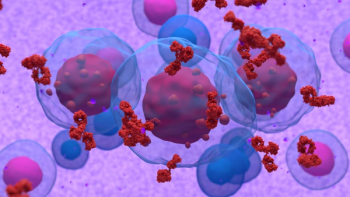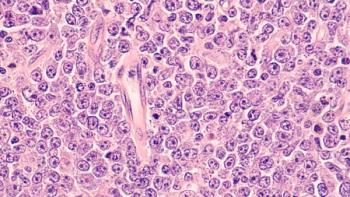
Understanding the Essentials of Biosimilars: What Oncology Nurses Need to Know
Teresa Knoop, MSN, RN, AOCN, says it is important for oncology nurses to understand the naming convention of biosimilars as it is an important aspect of anticipating adverse events.
Oncology nurses must understand how biosimilar products function and how they compare to other drugs on the market, according to a presenter at the 5th Annual School of Nursing Oncology meeting.
Although the first biosimilar for the treatment of multiple cancers was not approved until 2017, oncology nurses have had to brush up on their knowledge of those drugs ever since Congress passed the Biologics Price Competition and Innovation Act in 2009.
Teresa Knoop, MSN, RN, AOCN, director at large, Oncology Nursing Society Board of Directors, outlined how nurses can differentiate between biosimilars and generic drugs.
The first thing that nurses need to understand, according to Knoop, is what a biosimilar is. A biosimilar is a biological product that has been approved by the FDA based on evidence that the drug is highly similar to a preexisting biological product (the reference product, or originator) that has also been FDA approved. For a biosimilar to be approved, it must demonstrate that it induces no clinically meaningful differences from the original product in terms of safety, purity, or potency. For the biosimilar to be accepted as highly similar, only minor differences in clinically inactive components are permissible.
As an example, Knoop explained that “the drug trastuzumab, which has been around since 1998, would be considered a reference or originator product. The biosimilars that are then produced have to have studies that prove the safety and efficacy against the originator the reference product, trastuzumab.”
Biologic products are often more difficult to characterize than small molecule drugs due to their generally large, complex nature, she said. They are produced in living systems using biotechnology.
While biosimilars go through abbreviated approval pathways, they are tested against reference products which were approved after undergoing a rigorous testing process and multiple phase 3 and phase 4 trials. The biosimilars are screened for their similarities to these approved original products through studies assessing pharmacokinetic exposure, pharmacodynamic response, clinical immunogenetic, and they are also screened through additional clinical studies, if needed.
Additionally, the immunogenetic assessments can also be quite rigorous as, according to Knoop, “they have to prove that this biosimilar is not creating an immunogenicity (which) means that your body is developing antibodies to the drugs. So, you have to prove that your body — with these biosimilars — (is) not producing anti-drug antibodies”
Difference Between Generic and Biosimilar Drugs
As Knoop explained, it is also important for oncology nurses to recognize how biosimilars differ from generic drugs. The two share certain similarities; they undergo abbreviated approval processes, they are both versions of brand name drugs, and they share the same active ingredients as the brand name drugs. Both drugs are also useful because they “help to complete the cost of clinical trials and shorten the time that we can get these drugs to market.”
However, the responsibility of biosimilar manufacturers differs from those who manufacture generic drugs because they need to prove that their product is highly like the originator or reference product and that there are no clinically meaningful differences between their product and the reference.
In addition, biosimilars are biologic products, while generic drugs consist of a chemical composition, and, because of this, the active ingredients in generics are the same as in the brand name. This is different than in biosimilars.
Knoop noted that, “it is acceptable that there will be a few product variations due to manufacturing because these are based on living mechanisms and biotechnology, even in a reference product. This is true in the reference product and the biosimilar is therefore also allowed to have those kinds of variations so long as they have no meaning on the outcome of the drug treatment.”
Biosimilar Indications
In continuation, a biosimilar might receive the same number of indications that its reference drug has, or it might have fewer. If an originator product has an unexpired exclusivity, this can impede on the corresponding biosimilar’s ability to obtain the same extent of indications. Knoop’s response was to encourage nurses to understand this and ensure that they review the prescribing information each time a new biosimilar is approved, so that they understand which indications the approval encompasses.
She also explained that an interchangeable product would be a biosimilar that has demonstrated such a high similarity to the original product that the two could be interchanged without consulting the prescriber.
As of now, no cancer biosimilars are interchangeable, partly because the amount of information needed for the FDA to approve an interchangeable product is extensive. The process involves multiple clinical trials, including “switching studies,” where the interchangeable product is switched with the original to certify that it produces the same clinical results in every patient.
Despite the number of years and clinical trials needed to approve an interchangeable biosimilar product for cancer, oncology nurses should watch for this and understand that manufacturers would need to prove that their product produces the same clinical result as the reference product for the FDA to conclude that the two are interchangeable.
Understanding the Generic Naming System
Knoop offered a couple useful reminders on how oncology nurses can navigate the naming conventions of a couple different biosimilars. She explained that understanding the naming system and their connection to the mechanism of action and the target of the drug is an important aspect of anticipating adverse events.
To recap, “TU” indicates that a drug will target a tumor. Tras(tu)zumab is a great example, she said, because it targets HER2 breast cancer tumors and adverse events will therefore be related to targeting the tumor. A drug with “CI” refers to the circulatory system. Knoop explained that “in circulatory beva(ci)zumab, the target are the epithelial cells that grow in the circulatory system and are part of the tumor’s blood supply. This should alert nurses to look for circulatory adverse events, such as wound healing, bleeding, proteinuria, and circulatory high hypertension.”
Finally, an “L” or “Li” indicates that the drug is targeting the immune system. A great example of this, according to Knoop, is ipi(li)mumab. This monoclonal antibody functions by affecting the immune system. Understanding this allows nurses to proactively anticipate the patient’s responses.
Additionally, Knoop reminded nurses that in 2017, it was decided that all biologic products would have a suffix with four lowercase letters devoid of meaning attached to the name. Knoop stressed that nurses should recognize that not every new biologic product is a biosimilar.
“The FDA did not want biosimilars identified per se to it because they did not want to squelch competition, they wanted to make sure they were never seen as an inferior product,” she said. The FDA, according to Knoop, has therefore helped to foster a highly competitive, high quality market, which seeks to advance patient safety by allowing biosimilars a place to grow.
Reference
Knoop T. Biosimilars: Essentials for Oncology Nurses. Presented at: 5th Annual School of Nursing Oncology Live, Interactive Webcast. August 6-August 7, 20201.
Newsletter
Knowledge is power. Don’t miss the most recent breakthroughs in cancer care.

















































































